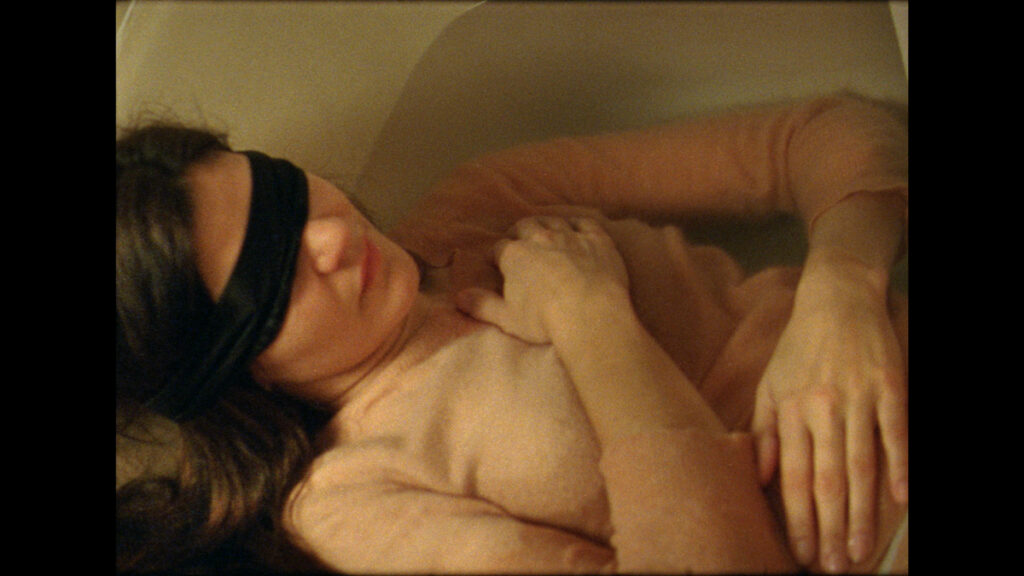
‘Embrace’
A film written, directed, edited, produced by Elzbieta Piekacz {Mela Hilleard}
Short, Experimental, Art House, Drama, Author Cinema
3’, Colour, 16mm, 25 fps, 1.85, English, UK 2015
SYNOPSIS
Inspired by the painting of Leonardo Da Vinci – Virgin of the Rocks. Marianna, a 40 year old woman who’s life seems stuck in a cave, until the bird is singing announcing spring and resurrection.

ARTICLE
http://issuu.com/cinewomen/docs/cinwom_iss1516_jan_16_art_cinema/68
There is a profound link between fine arts and film, so I have used a painting as an inspiration for a story. A painting which has been always with me since London ‘embraced’ me 7 years ago was painted by Leonardo da Vinci and is called Virgin of the rock.
From the beginning I knew that I wanted to create a story that’s written on light. I always had passionate desire to be able to tell the story where the light will be one of the main narrations. Light is everything to me. Light is life. It’s a beginning and end of everything – the inner light of person, light in the room, light of past moment, waiting for the light. Always looking for signs and meanings I collect proof of life’s magnificence with images, I get concrete evidence of it ‘written in light’.
I followed the unique understanding of light and colours as expressed in the story by Vittorio Storaro,’Writing With Light’. He says,‘Photography means writing with light’.[7]
I attended a workshop that was run by The National Gallery called ‘Art through word’ that was for people who are blind or having difficulties to see. The paintings were described with words and with touch of the contours. Probably that was the moment when I decided I wanted a voice-over on the film that I was about to make.

One of the main inspirations thorough my life as a director was the legendary Andriej Tarkowski and especially his film “Stalker”[1] and by watching it I was
trying to analyse composition and the movement that the
camera is making. „Tarkovsky developed a theory of cinema that he called “sculpting in time”. By this he meant that the unique characteristic of cinema as a medium was to take our experience of time and alter it.”[2]
Later when I was visiting the Scriptwriting Clinic that was run by the LFS script-writing students, Jada Nation compared my script to Elena by Petra Costa [3]. „A film about the persistence of memories, the irreversibility of loss, the effects of her sister’s absence on a 7-year-old girl, emotions which Petra refers to as inconsolable memories. Gradually, the pain and grievance turn to water, they dissolved into memory.”[4]
During the scriptwriting process I developed the story of Marianna who is entering her middle age and lives in a house that feels like a cave. Because of the eye infection she wears a black band over her eyes. She hears voices that remind her of things that happened or
could have happened but did not. In the background, intermixed with the sound effects, a voice is heard reciting passages from the New Testament – the written essence for me about love, which start with: “If I speak in the tongues of men and of angels, but I do not have love, I am only a resounding gong or a clanging cymbal.” (Corinthians 13) The story moves to a scene where Marianna is seen lying clothed in a bathtub wandering if she should commit suicide. This was inspired by Sir John Everett Millais painting Ophelia.

I tried to use a lot of symbols. The name Marianna comes from the Semite name Mary. Both characters are linked with children. Mary gave birth to Jesus after the Immaculate Conception, Marianna is distressed when asked if she had any children. The story I was trying to create was very direct about Marianna’s pain, which was depicted with her eyelid twitching. Marianna blindness has also for me a symbolic meaning. Black band on her eyes, which she put it by herself, is not being able to give love to the child, to the man, to mother, to herself.
Da Vinci’s painting did influence the film’s mood but it was Ophelia that gave it a unique twist. Ophelia’s dead body seems here almost as a part of the nature. But her death is anything but natural. Her eyes were left half opened and her mouth as though craving for a kiss. They seem hungry for love and life and her stretched hands are open for an embrace, trying to cling to life. The eyes of Marianna are blinded with a black band and her mouth is closed, but she is unwillingly surrendering to death too, undecided yet about what to do. Hence, the painting set a strong tone that echoed strongly in this shot. Marianna is laying clothed in a bathtub listening to the voices of the past whilst next to her we can see pills that she might or might not have taken, because the memories are a cruel judge and the darkness lasted for too long.
Because of the light continuity the first scene that we shot, was the last scene from the film. I named this scene a resurrection because Marianna is no longer wearing the black band on her eyes. She survived the voices and the hurt, resisted the temptation of committing suicide and goes back into the life again while the song of the birds wake her up carrying her back to the present and into the life and love.

As a director I had to made a decision to change the actress one day before the shooting. I asked to play the role of Marianna person which I saw once in my life and in the end it turned out to be great choice. I was very happy that I trusted my intuition. During the shooting I found the character of Marianna in my actress and it was such a blissful feeling. I follow Robert Bresson method of acting: „BEING instead of SEEMING”[5]. I don’t have to explain my actress anything. She just fill the character with her presents. The actress I had rehearsal recorded voiceover for „Embrace” later on.
I spoke with my Director of Photography – Vasilka Avramovska and told her that I want to achieve shadows and lights like on Leonardo’s painting. I was also aware about significant number of four – like four characters on the painting. I wanted to achieve similar colours and atmosphere like in the Da Vinci’s painting especially in
the details like white egg, white lilies, the colour of the actress’s costume.
We used AATON camera 16mm colour 4:3. With my DoP together with the gaffer we tried to create natural and soft lighting. For the scenes I wanted to use mostly a 25mm lens. The aperture was set mostly on 1.8. We used also a miniature torch, which DoP directed straight into the actress’s eye in the scene of the eye exam. We had only one day shooting – twelve hours. We managed to shoot all scenes as the DoP and I originally planed. From 5 min of stock I used 2:35 min to create the film which allowed us to do just one take for each scene.

I was thinking about many places as a location but finally I used my room, putting around things, which could belong to Marianna – I ‘lived with them’. I didn’t clean the room, to make this more real adding and removing stuff. It looked so real because when my crew came they told me that I should have cleaned my room a bit before the shooting.
During editing process I cut the first scene of Marianna’s eye exam and I added them as a layers to other scene. I like mixing two different worlds together. I like when things have their history, imperfections, unspoken, reflections. I was always interested in breaking conventions. I started thinking more about this film in terms of poetry – as a visual essay.
I wanted from the very beginning the film to be accompanied by the music of violoncello. It is an instrument, but in my film it would be one more voiceover that’s connected with the character, repeated as a meditation through entire movie together with the additional fourth layer after Marianna’s voice, the voices of the Baby, the Man, the Mother.
I had taken risky decisions with the handheld camera and underexposed lighting, but during the editing process and later with the voiceovers/sound effects and music, everything fitted perfectly and I was very happy. It was like „love to adopted child”. I saw different movie to that was rolling in my mind, but then I embraced it anyway and I felt proud and thankful to all my crew who helped me to feel this feeling.
Filmography:
[1] Stalker (1979) Dir. Andrei Tarkovski.Prod company Mosfilm. Main Cast: Alexander Kaidanovsky, Anatoli Solonitsyn, Nikolai Grinko
[3] Elena dir. Petra Costa (2012)
[6] „Apocalypse Now” (1979) Dir. Francis Coppola. Prod Francis Coppola. Main Cast: Marlon Brando
Bibliography:
[2] „Andrei Tarkovsky: The Philosophy Of Cinema” As Artby Bhushan Mahadani
[4] „Petra Costa e Caetano Gotardo fazem cinema intimista” O Estado de S. Paulo
[5] „Jean-Luc Godard and Vivre Sa Vie” Tom Milne „Directing Actors” Robert Bresson
[7] „Writing With Light” by Vittorio Storaro
CAST
Marianna – RR
Man Voice – Mark Martin
Woman Vice – Anne Wittman
CREW
Written, Directed, Edited, Produced by Elzbieta Piekacz
Director of Photography – Vasilka Avramovska
Camera Operator – Sining Wang
Camera Asistant – Seiichiro Itoyama
Gaffer – Chloe Deleplace
Assistant Director – Victoria Romero
Composer – Mahlon Berv
Sound Mix: Joe Watts
